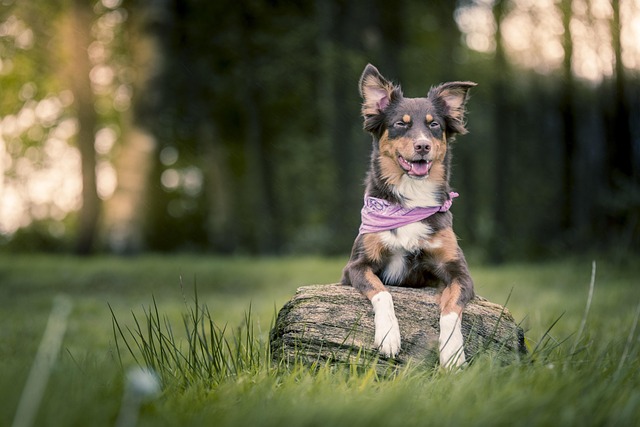
How to train a dog to bite back?
Training a dog to have defensive biting ability is not merely about releasing its attack instincts. Instead, it is based on a high level of trust between humans and dogs.
On a sunny afternoon, taking a walk in the park with your dog was supposed to be a pleasant time, but when you encountered other dogs, your furry child suddenly rushed forward and let out bursts of rapid and sharp barking, instantly breaking this tranquility. Watching the dog's tense body and vigilant gaze, and then looking at the gazes around, as the owner, I feel both embarrassed and worried. Dogs do not express emotions in human language, and barking is one of their ways of communicating with the outside world. Behind every bark, there are their feelings and needs. When dogs bark at other dogs, what we need to do is not to rush to scold them, but to use professional knowledge and warm love to understand their "inner voice" and take the right measures to guide them to learn to be friendly with each other.
Dogs barking at other dogs have complex and diverse reasons behind it. From a behavioral and psychological perspective, fear is one of the common factors. Dogs have sensitive senses, and the body shape, scent, barking, and even a glance from an unfamiliar dog can make them feel scared. For example, when a small dog encounters a large unfamiliar dog, it may feel fearful due to the disparity in its own strength, and then try to drive away the other person by barking. In fact, this is its instinctive self-protection reaction. Just like humans unconsciously shout out loud to boost their courage when they are afraid, dogs use barking to boost their courage, hoping to scare off potential "threats".
Territorial awareness often triggers barking behavior in dogs. In the cognition of dogs, the home they live in, the areas they often play in, and even their owners belong to their "territory". When other dogs enter this area, they will think that their territory has been violated and issue a warning by barking. This intimidating barking, accompanied by a posture of leaning forward and raising hair, is a declaration of sovereignty and a warning to the other party not to approach easily. For example, when a stranger dog approaches their yard, the originally quiet dog will immediately rush to the door, barking loudly and pacing back and forth until the other person leaves before refusing to stop.
Resource competition is also an important reason why dogs bark at other dogs. Food, toys, and owner's attention are all precious resources in the eyes of dogs. When two dogs are interested in a toy at the same time or both want their owner's touch, they will demonstrate to each other by barking. At this moment, barking is full of aggression, and the dog will stare at the target resource with fierce eyes, ready to defend its "interests" at any time. In addition, poor social communication may also lead to misunderstandings. Dogs have a unique way of socializing, and when they don't know how to express friendliness correctly or misunderstand each other's body language, they may also communicate through barking, which in the eyes of humans is like "arguing".

When a dog barks at other dogs, the owner should first remain calm. Your emotions can directly affect the state of your dog. If the owner shows nervousness, anxiety, or even scolds the dog loudly, it will exacerbate its anxiety and make the situation worse. Only with a calm and composed tone and a firm attitude can dogs feel secure and authoritative. If a dog barks out of fear, it should be taken away from the environment that makes it feel scared and away from the source of the fear in a timely manner. Squat down, call out its name in a gentle tone, gently stroke its head and back, slowly move your palm in the direction of its hair, and give comfort, just like comforting a frightened child. After the dog's emotions have stabilized slightly, try to let it come into contact with other dogs, but keep a safe distance and let it gradually adapt.
If barking is caused by territorial awareness or resource competition, the owner should intervene quickly and cautiously. You can use your body to block between two dogs and issue commands such as "stop" and "quiet" in a firm tone. If the dog is small in size, you can also use a leash to gently pull them apart, but be careful not to use too much force to avoid pulling the dog. After the dog stops barking, timely rewards such as snacks and compliments should be given to make it understand that quietness is the key to recognition. In order to prevent similar situations from happening again, it is necessary to strengthen the training of dogs' territorial awareness and resource possessiveness in daily life, and teach them to learn to share and accept the presence of other dogs.
When dogs bark due to social communication issues, it is appropriate to guide them to engage in proper socialization while ensuring safety. Allowing dogs to sniff each other in a relaxed and natural state is an important way for them to understand each other. If a dog shows friendly behavior, such as gently wagging its tail or relaxing its body posture, it should be encouraged and rewarded in a timely manner; If there is any inappropriate behavior such as barking again, use commands and actions to stop it in a timely manner, and shift their attention to oneself. At the same time, provide socialization training for dogs from a young age, take them to interact with different people and animals, familiarize them with various social scenarios, and learn the correct way to socialize.
Prevention is equally important in solving the problem of dogs barking at other dogs. Regularly bring your dog to social activities, allowing it to interact with other dogs in a safe and friendly environment, and accumulate positive social experiences. By using positive incentives to reinforce good behavior in dogs, timely rewards and praise should be given when they get along well with other dogs; When there is bad behavior such as barking, no reward will be given and appropriate guidance will be provided. In addition, meeting the exercise and psychological needs of dogs is also crucial. Dogs who are energetic but have nowhere to release themselves are more likely to become emotionally excited in social situations. Ensuring sufficient exercise and rich interactive games every day can help dogs maintain a calm mindset.
Dogs accompany us with loyalty throughout their lives, and when they encounter problems in social interactions, we are their strongest support. When a dog barks at other dogs, every calm response and patient guidance is filled with our deep love and responsibility towards them. Watching the dog that used to easily bark excitedly, with our efforts, being able to coexist harmoniously and play happily with other dogs, the sense of satisfaction and achievement is indescribable. May we all become excellent "social mentors" for dogs, using professionalism and love to help them gain friendship and happiness in the social world of "dogs", and enjoy a beautiful life.

Training a dog to have defensive biting ability is not merely about releasing its attack instincts. Instead, it is based on a high level of trust between humans and dogs.

When we watch dogs sniffing around with curiosity, their smart eyes flashing with the light of exploration, we will realize their innate instinct of exploration.

When your lovely Teddy suddenly bares its tiny teeth and nibbles at your fingers or clothes, or accidentally scratches your skin during play,

In the morning, sunlight filters through the window into the room as you carry a bowl of carefully prepared dog food toward the shepherd dog.

In the world of dogs, smell is their unique language for perceiving the outside world and a mysterious bridge for communicating with humans. Dogs' sense of smell is dozens or even hundreds of times more sensitive than that of humans.

When dogs explore the world with their teeth, furniture often becomes their "teething victims." This not only frustrates owners but also reveals the deeper needs behind their behavior.